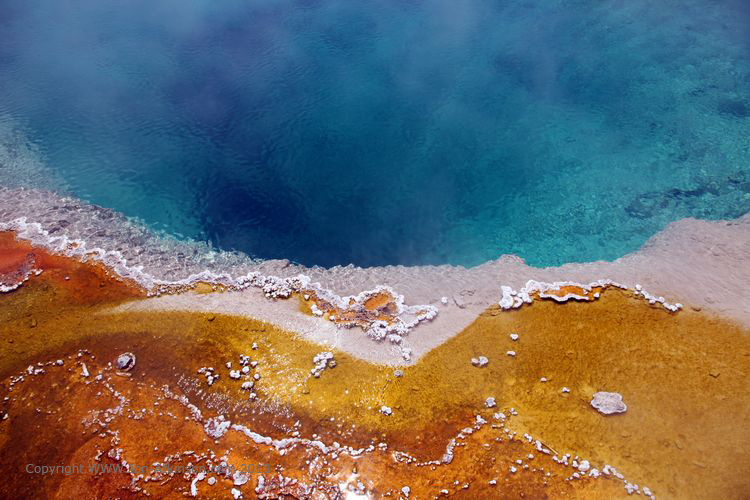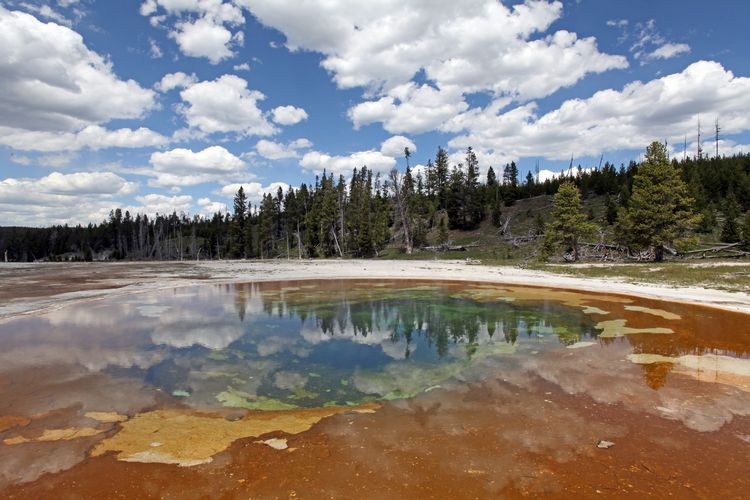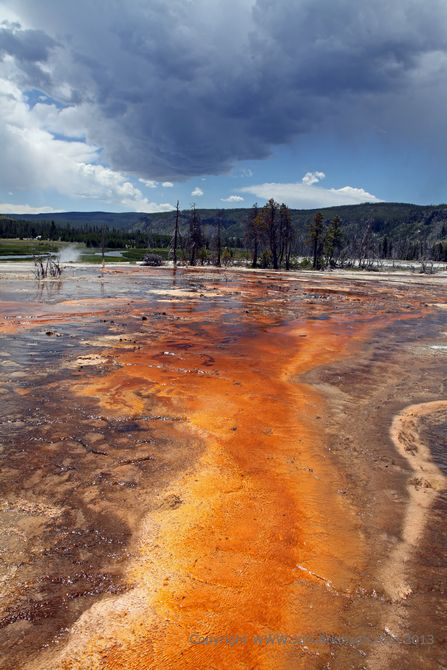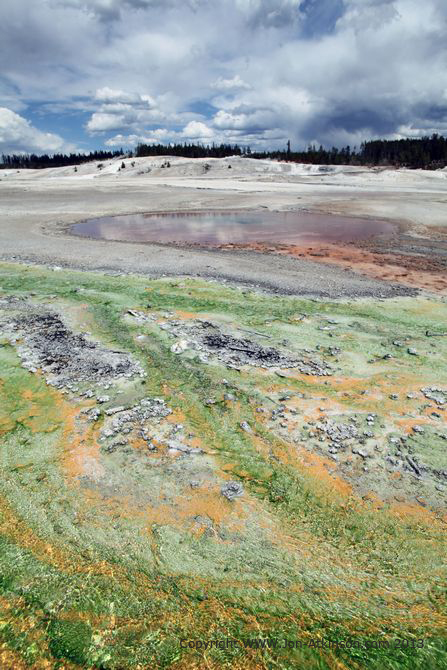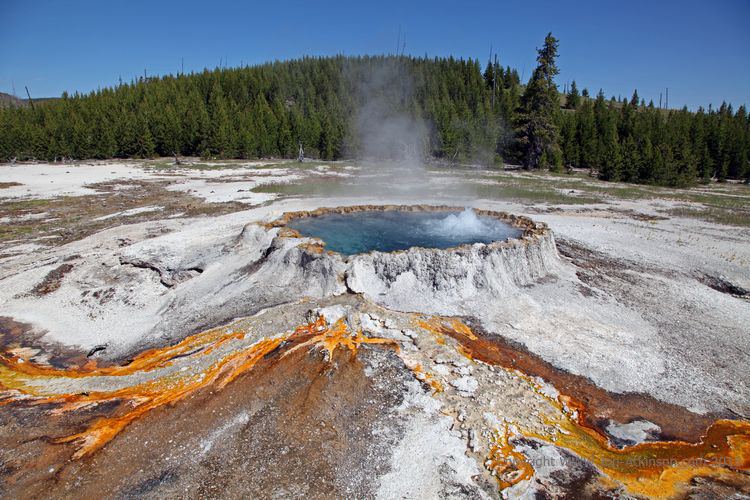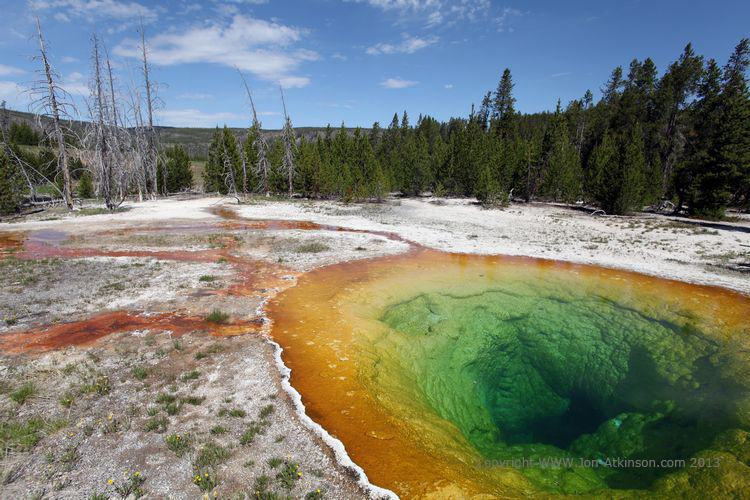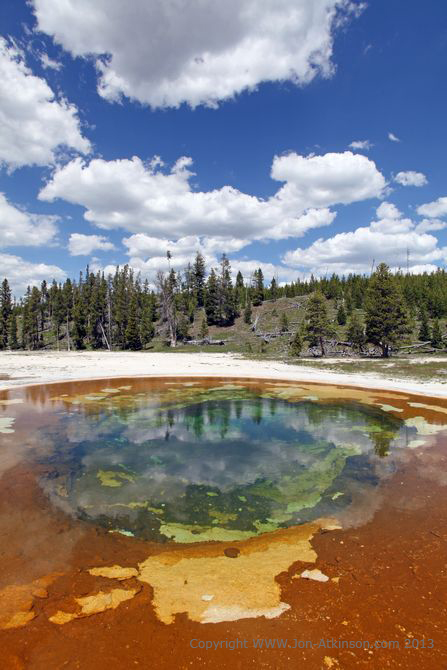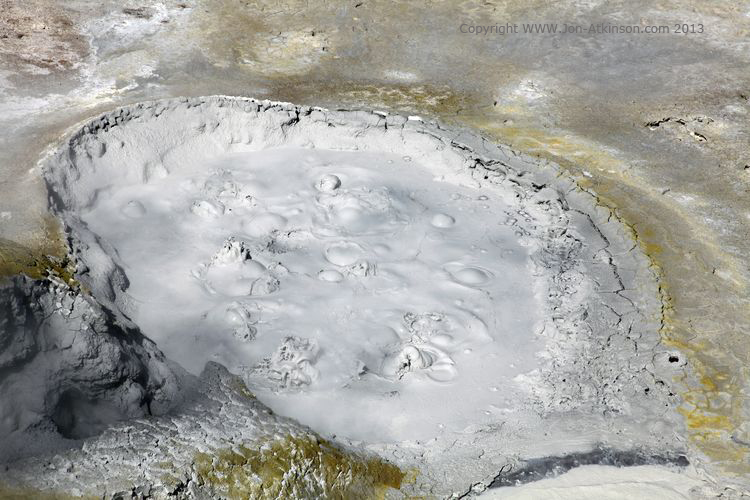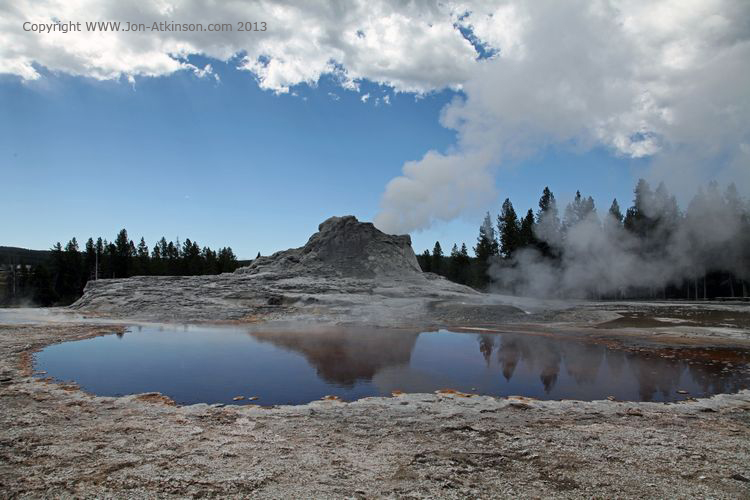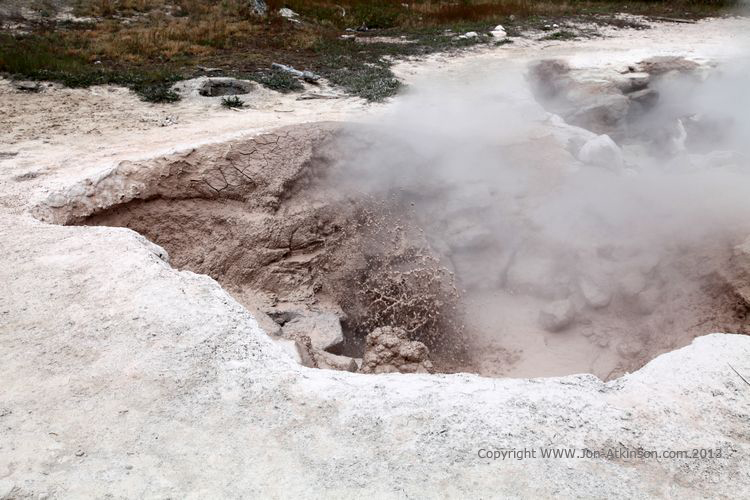GEO1 - West Thumb Geyser Basin, Yellowstone National Park: West Thumb Geyser Basin stands out because it is on the edge of, and partially submerged by, Yellowstone Lake, which creates a dramatic backdrop for the dynamic geysers, pools, and springs. |
GEO2 - West Thumb Geyser Basin, Blue Funnel Spring: Blue Funnel Spring is one of the larger pools and one of the most striking because of its circular rim and pastel blue color which intensifies as the pool deepens towards its central vent. The hottest pools are the bluest since colorful cyanobacteria that live in cooler springs change the color of those springs.. |
GEO3 - Upper Geyser Basin, Beauty Pool, Yellowstone National Park: Chromatic Spring is located in the Upper Geyser Basin of Yellowstone National Park. It is connected to the nearby Beauty Pool. During periodic energy shifts the level of one spring descends while the other rises and overflows. The time interval between shifts has ranged from a few weeks to several years. |
GEO4 - Upper River Basin, Morning Glory Pool, Yellowstone National Park: Morning Glory Pool was named by the wife of an Assistant Park Superintendent, in 1883, after she called it "Convolutus", the Latin name for the morning glory flower, which the spring resembles. By 1889, the name Morning Glory Pool had become common usage in the park.
| GEO5 - Biscuit Basin, Yellowstone National Park: Biscuit Basin is named for the unusual biscuit-like deposits that used to surround Sapphire Pool. Lake Earthquake, Sapphire erupted, and the "biscuits" were blown away; it last erupted in 1991.Mustard Spring provides a bright color contrast. |
GEO6 - Norris Geyser Basin, Yellowstone National Park: The Norris Geyser Basin is the hottest, oldest, and most dynamic of Yellowstone's thermal areas. The highest temperature yet recorded in any geothermal area in Yellowstone was measured in a scientific drill hole at Norris: 459°F (237°C) just 1,087 feet (326 meters) below the surface.
|
GEO7 - Biscuit Basin, Hot Pools Yellowstone National Park: Three hot pools - Black Opal Spring, Wall Pool, and Black Diamond Pool are located on the right side of the trail immediately after entering the Biscuit Basin. |
GEO8 - Punch Bowl Spring, Yellowstone National Park: Punchbowl Spring is an accurately-named spring at Yellowstone. It is about 3.5 meters in diameter and is contained by a "punch bowl" of scalloped sinter about 1 meter high. The spring is deceptively deep (more than 6 meters) and constantly boils away as seen in this image, with water running off through several channels. |
GEO9 - Upper River Basin, Morning Glory Pool, Yellowstone National Park: The distinct color of the pool is due to bacteria which inhabit the water. On a few rare occasions the Morning Glory Pool has erupted as a geyser, usually following an earthquake or other nearby seismic activity. |
GEO10 - Travertine Terrace, Mammoth Hot Springs, Yellowstone National Park: At Mammoth Hot Springs water rises through the limestone, carrying high amounts of dissolved calcium carbonate. At the surface, carbon dioxide is released and calcium carbonate is deposited, forming travertine, the chalky white rock of the terraces. |
GEO11 - Upper Geyser Basin, Beauty Pool, Yellowstone National Park:With a diameter of 18 meters, it is perhaps the largest spring in the Upper Geyser Basin, and one of the prettiest, filled with clear, greenish blue water and edged by a wide band of orange and brown cyanobacteria, which extends almost to the boardwalk trail. |
GEO12 - Liberty Cap, Mammoth Hot Springs, Yellowstone National Park: Estimated to be 2,500 years old the 12 meter high Liberty Cap, which was created by a hot spring that was active in one location for a long time. Its internal pressure was sufficient to raise the water to a great height, allowing mineral deposits to build slowly and continuously for perhaps hundreds of years. |
GEO13 - Mud Spring, Mud Volcano Area, Yellowstone National Park: The term mud volcano or mud dome are used to refer to formations created by geo-excreted liquids and gases, although there are several different processes which may cause such activity. Hot water mixes with mud and surface deposits. Depending upon the precise definition of the term mud volcano, the Yellowstone formation could be considered a hydrothermal mud volcano cluster. |
GEO14 - Castle Geyser, Upper Geyser Basin, Yellowstone National Park: Castle Geyser has the largest cone and may be the oldest of all geysers in the basin. Its eruption pattern has changed considerably throughout its recorded history. Castle is currently erupting about every 10 - 12 hours. A water eruption frequently reaches 27 meters and lasts about 20 minutes. The water phase is followed by a noisy steam phase lasting 30 - 40 minutes. |
GEO15 - Fountain Paint Pot Trail Geothermal Feature, Yellowstone National Park: The Fountain Paint Pot is named for the reds, yellows and browns of the mud in this area. The differing colors are derived from oxidation states of the iron in the mud. As with all hot springs, the heat in the caldera forces pressurized water up through the ground, which is expelled here. Also, rising gasses cause the bubbling action. |

